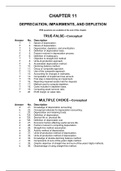Exam (elaborations)
Test Bank Chapter 11 Depreciation, Impairments, and Depletion.
- Course
- Institution
CHAPTER 11 DEPRECIATION, IMPAIRMENTS, AND DEPLETION IFRS questions are available at the end of this chapter. TRUE-FALSE—Conceptual Description T 1. Nature of depreciation. F 2. Nature of depreciation. T 3. Depreciation, depletion, and amortization. T 4. Definition of depreciation base. F...
[Show more]



